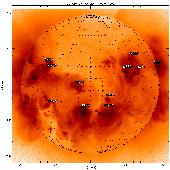
We at last have major solar flares to study again - four in October, after
several months with one or none.
In the
most recent science nugget , we reported one of the two X-class flares,
which unusually occurred on the same day (October 19).
Both of these October 19 events occurred in the same active region.
The next two October events occurred in a different region, though,
at 20 degrees south latitude (October 22 and 25).
Here, some careful readers of our science nuggets might recall something.
Yes, it's a new rotation of the "active region complex", we described in the
12-Oct-2001 edition !
From 17th through 29th October, this region complex made its fourth disk
passage,
and during which its eastern part, NOAA 9672, produced two X-class flares on the
22nd and 25th.
Normally a solar active region will make major flares early in its life,
and then settle down a more sedate existence (but still possibly capable
of coronal mass ejection; this is a developing story that we'll surely
report on in the future).
In this case a veteran complex of activity demonstrated again that the
occurrence of activity is far from a random process; on its fourth rotation
this complex still found enough emerging flux (we believe) to fire off
two X-class flares.
It is presumably an example of an
active longitude.
A Sequel to a
Life Story
A portrait of this active region complex at its fourth rotation is below. Please look at a little south of the disk center, at around 20 degrees. This region complex consists of two regions numbered 9672 (eastern) and 9670 (western). Since the latter consists of two spots separated more than 10 degrees in longitude, the whole complex extends nearly 30 degrees, which corresponds to 265 through 295 degrees Carrington longitudes (this is a coordinate system rotating with the Sun).

The above movie shows the evolution of the complex from 18th to 29th October. Comparing the configuration of sunspots and magnetic field patterns between the previous and current rotations, it is more likely that AR 9670 and 9672 are the aged (somewhat decayed) re-appearances of AR 9628 and 9632, respectively. This means they are not newly emerged regions. However, one notable phenomenon would be the emergence of new positive polarity (colored white in the magnetogram here) in the northwest vicinity of the AR 9672, a negative (black) polarity spot. It is clearly there on October 21. Subsequently, on the boundary of these two polarities, the first X-class flare occurred on the 22nd. The spot in AR 9672 continued to grow significantly and there followed the second X-class event on the 25th. On the contrary, the western part of the complex, AR 9670, appeared to decay and went rather quietly beyond the limb.
So, to summarize: the regions of the complex rotated back onto the visible
hemisphere, but new flux emergence occurred within them.
Two X-class flares
Let us look closely at the X-class flares observed with our SXT. Same as the last week's nugget, the movies below show many things. The top of each frame shows the soft X-ray intensity of the time of each X-ray image; bottom left shows wide-angle (~10 arc min FOV); bottom right is a close-up of the core part of the flaring region (~2.5 arc min FOV).


The 22-Oct event turned out to be comprised of two stages of eruption; the first event, started around 14:40 UT, marked an M-class flare, in which the core part looked to elongate toward southeast. It also accompanied eastward ejection in the early phase. The second event, corresponding to the X-class flare around 18:00 UT, began at almost the same place but spread toward quite different direction, i.e., to the southwest. Each of these major flares, as is the usual pattern, had a coronal mass ejection. Oddly the first event (M-class) looks more spectacular than the second (X-class) event in the following movie of the October 22 events as observed with the SoHO/LASCO coronagraphs. Is this because the corona above the flares had been depleted and not yet restored properly?
As for October 25, SXT did not have such good data coverage,
but we can see a southward ejection in the early phase
(until 15:20 UT in the wide-angle panel).
Conclusion
The two X-class flares reported on October 22 and 25 were from an old friend at 20 degrees south - a complex of activity re-born on its fourth rotation as AR 9672, apparently made active again by the emergence of new magnetic flux within the old complex. We had followed it through three rotations in the previous science nugget, not really expecting a resurgence of activity. Was this resurgence related to the new activity in the north (October 19) in a different region? We often see roughly simultaneous (on this scale) activations of distant active regions.